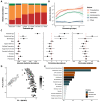Dynamics and Crosstalk between Gut Microbiota, Metabolome, and Fecal Calprotectin in Very Preterm Infants: Insights into Feeding Intolerance
- PMID: 38004243
- PMCID: PMC10674500
- DOI: 10.3390/nu15224849
Dynamics and Crosstalk between Gut Microbiota, Metabolome, and Fecal Calprotectin in Very Preterm Infants: Insights into Feeding Intolerance
Abstract
Background: Feeding intolerance (FI) is a significant concern in the care of preterm infants, impacting their growth and development. We previously reported that FI is linked to lower fecal calprotectin (FC) levels. This study aims to explore the postnatal dynamics and interplay between microbiota, metabolic profiles, and host immunity in preterm infants with and without FI.
Methods: Infants with gestational age <32 weeks or birth weight <1500 g were enrolled at the Children's Hospital of Fudan University between January 2018 and October 2020. Weekly fecal samples were analyzed for bacterial profiling, metabolome, and calprotectin levels, exploring their longitudinal development and interrelationships.
Results: Of the 118 very preterm infants studied, 48 showed FI. These infants experienced an interrupted microbial-immune trajectory, particularly at 3-4 weeks of age, marked by a reduced bacterial abundance, alpha diversity, and FC levels. Metabolic changes in FI were pronounced between 3 and 6 weeks. Pantothenic acid and two polyamine metabolites were closely associated with bacterial abundance and FC levels and negatively correlated with the duration to attain full enteral feeding.
Conclusions: FI infants demonstrated compromised microbiome-immune interactions, potentially influenced by specific metabolites. This research underscored the importance of early microbial and metabolic development in the pathogenesis of FI in very preterm infants.
Keywords: calprotectin; feeding intolerance; microbiome; pantothenic acid; polyamine metabolites; preterm infants.
Conflict of interest statement
The authors declare no conflict of interest.
Figures




References
MeSH terms
Substances
Grants and funding
LinkOut - more resources
Full Text Sources
Medical

